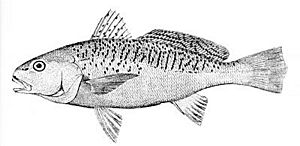Atlantic croaker facts for kids
Quick facts for kids Atlantic croaker |
|
|---|---|
 |
|
| Conservation status | |
| Scientific classification |
The Atlantic croaker (Micropogonias undulatus) is a type of fish that lives in the ocean. It's part of the Sciaenidae family, which includes other well-known fish like the black drum, spot croaker, and red drum. You can often find this fish in bays and estuaries from Massachusetts all the way down to the Gulf of Mexico.
Description
The name "croaker" comes from the unique sound this fish makes! It vibrates strong muscles against its swim bladder, which acts like a drum. This makes the Atlantic croaker the loudest fish in the drum family. People sometimes call it a "hardhead," and smaller ones are known as "pin heads."
During their spawning season, from August to October, croakers turn a deep golden color. This is why they are sometimes called "golden croakers." In August, tiny young croakers swim into the Chesapeake Bay. They travel to creeks with low salt levels or even freshwater. For the winter, they move to deeper parts of tidal rivers.
The young croakers leave the bay with the adults the following autumn. When they are fully grown, usually at 2 to 3 years old, croakers can be 18 to 20 inches long. They can weigh 4 to 5 pounds, but most are about 1/2 to 2 pounds. These fish can live for up to 8 years.
The largest Atlantic croaker caught in the Chesapeake Bay weighed 8 pounds, 11 ounces. It was 27 inches long and was caught in August 2007 near New Point Comfort Lighthouse in Virginia. Native Americans have traditionally used these fish for food. Their remains are often found in old shell middens. Today, croakers are still very popular with people who like to fish for fun.
Distribution and habitat
The Atlantic croaker lives in the coastal waters of the western Atlantic Ocean. Its home range stretches from Massachusetts down to Mexico. It also includes the northern part of the Caribbean Sea. Some people think it might also live along the coasts of southern Brazil and Argentina.
You can usually find croakers in bays and estuaries. They prefer areas with sandy or muddy bottoms. Here, they search for food like worms, crustaceans (like crabs or shrimp), and small fish. Croakers visit the Chesapeake Bay from March through October. They can be found all over the Bay, even as far north as the Susquehanna Flats.
Management
The number of croakers can change a lot from year to year. Their population often depends on the health of their habitats. Because their numbers vary so much, managing them can be a challenge. However, the Atlantic croaker has a wide range and a large population overall. For these reasons, the IUCN (International Union for Conservation of Nature) lists them as a species of "Least Concern." This means they are not currently at risk of disappearing.
See also
 In Spanish: Corvina de línea para niños
In Spanish: Corvina de línea para niños
Images for kids
-
Atlantic croaker in Pass Christian, Mississippi



